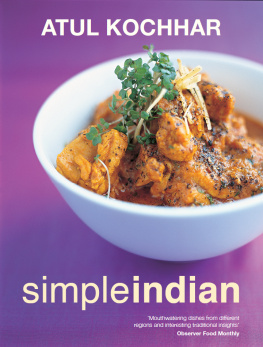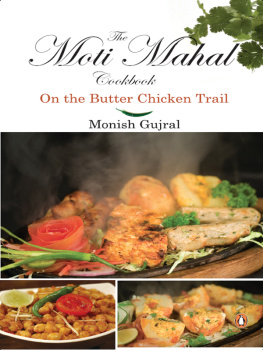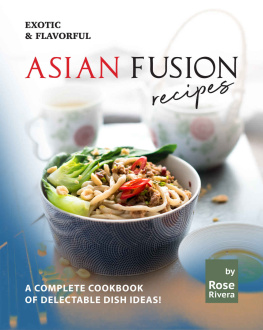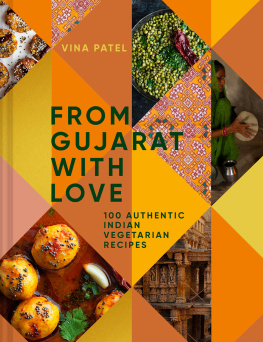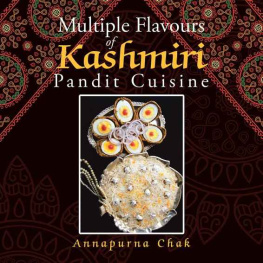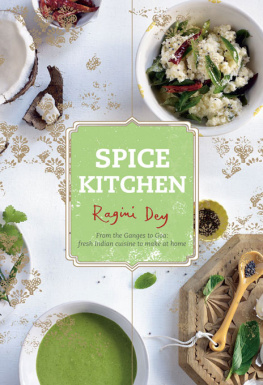




KASHMIR THROUGH ROMY-TINTED LENSES
When I was a child in India, growing up in West Bengal, we were the first family on our street to get a television an enormous black-and-white affair. Occasionally, we would invite neighbours and friends round to watch Bollywood movies. These were mostly filmed in Kashmir, the valley that was once the summer capital of the Mughals. With its stunningly beautiful lakes, snow-capped mountains and rolling meadows, it looked like paradise. It was partly these movies that were responsible for my fascination with this remote state, which straddles the Himalayas: one of the many, varied parts each with their own distinct culture that define the real India. Growing up, Kashmir felt like a foreign country to me, and I longed to visit.
It wasnt just the lofty mountains and rolling valleys of the region that captured my imagination: the people and the food also had a huge part to play. This is all down to my father, Santokh Singh Sandhu, who at the young age of 16 had travelled to Burnpur in West Bengal to work in a steel plant. Here, he worked alongside people from across India: colleagues and friends, including several families from Kashmir, with whom we shared numerous meals and celebrations. It meant that I learned a huge amount about their culture, their religion, their food, their language and their values and I learned even more when, just before winter came, Kashmiri traders would visit Burnpur with shawls, carpets, dried fruits and apples to sell. I have fond memories of my mother stocking up on purchases from Kashmiri people at this time of year, carefully bartering with them all before handing over any money.
Now, as a professional chef, Kashmir intrigues me for even more reasons: the various ways of living, speaking and feasting, and the different rituals ingrained into everyday life. With so much political uncertainty in the region, its cuisine and culture is increasingly difficult to access but I strongly believe that its a cuisine and culture that the world deserves to know more about.
In recent years, Ive learned more and more about my home country through my travels to places like Leh, the Andaman and Nicobar Islands, Himachal, and many more. Ive enjoyed the chance to eat, cook and learn about the food from each region, and then writing about it to share their incredible recipes and stories with a new audience. So, when I finally decided to travel to Kashmir, it would be no different: I was looking forward to enjoying the company of local Kashmiri people and seeing the region through their eyes.
I knew it wouldnt be an easy trip to plan. It was April 2021, and the COVID-19 pandemic had the world in its grip: every country had its own travel restrictions and its own regulations once you got there. Returning to India, when the countrys ever-increasing case rates and deaths were making global headlines, was certainly a risk but still, I was desperate to make this journey.
Great things never come from staying in your comfort zone. Anthony Bourdain once said, If Im an advocate for anything, its to move. As far as you can, as much as you can. Across the ocean, or simply across the river. [] Walk in someone elses shoes, or at least eat their food its a plus for everybody. So, I took the plunge and moved, spurred on by Bourdains words, and my vision.
It was worth it. The scenery, the people, the traditions, the love and, of course, the food all came together to create a truly incredible experience for me in Kashmir. As a chef, the trip was an education, and Im excited to share the Kashmiri recipes and techniques that I learned about here, in this book.
Kashmir, the northernmost region of India, is bordered by Pakistan to the north and west and China to the east. Unlike other places in India, Kashmir is largely untouched by foreign and domestic tourists, primarily because of its political situation.
In 1947, with the partition of India, both India and Pakistan tried to lay claim to Kashmir. Since then, fighting over the region has continued, and in 1990, the introduction of new powers for the military led to great government mistrust. As a result, over 70,000 Kashmiri Pandits fled the region, and continued to do so for the next decade. However, to me it was important to travel the parts unknown and to learn from them.


THE BASICS OF KASHMIRI CUISINE
Kashmiri cuisine draws its heritage from two different groups of people: the Pandits and Muslims. While there are differences between the two groups, there are also many similarities most importantly, the fact that they both offer such a rich fusion of styles and flavours in their food. Both cuisines draw heavily on Central Asian, Afghan, Persian and Mughal styles of cooking, and both share an affinity for lamb-based dishes, cooked over a wood fire.
Perhaps the most surprising difference between Kashmiri Pandit and Muslim cuisines, though, is the fact that Pandits will cook without onions or garlic: two of the staples of the majority of Indian regional cuisine. Conversely, two ingredients that you will find in Kashmiri Pandit cuisine, but rarely in Kashmiri Muslim cuisine, are hing (asafoetida), and curd or yoghurt-based sauces.
Each group brings its own style of richness to the table, with a deliciously aromatic blend of spices, including cloves, cinnamon, green and black cardamom, and ground fennel and ginger. Some of my favourite traditional dishes include the : chunks of tender curd cheese cooked in a mild cardamom and fennel-scented sauce, perfect mopped up with a flatbread.


An interesting anecdote I was told on my travels was that, at one time, every single Kashmiri Pandit home in the plains had a professional cook in residence. It meant that Kashmiri Pandits were able to enjoy a feast fit for royals at every mealtime. The women of the households received culinary training from these highly creative cooks. Over time, however, the cost of living grew higher and higher, and the expense of such a rich diet proved too costly, and so the era of these professional cooks came to an end. Some migrated to different industries; some opened their own small restaurants; and some are still cooking on a contract basis, providing sumptuous feasts for weddings and other special occasions.
KASHMIRI CUISINES CROWNING GLORY
Throughout different states in India, we have regional
Next page


